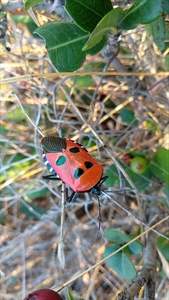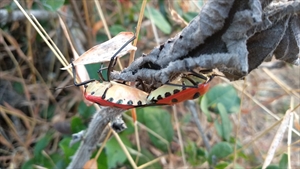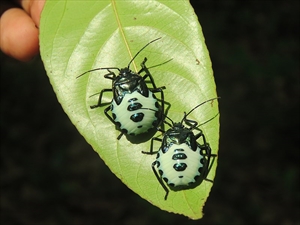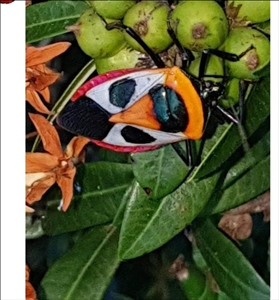Man-faced stink bug; also referred to as the Hitler bug.
Pacific Pests, Pathogens, Weeds & Pesticides - Online edition
Pacific Pests, Pathogens, Weeds & Pesticides
Man-faced stink bug (404)
Catacanthus incarnatus; also know by the name, Catacanthus nigripes. Another species, Catacanthus punctus, has been recorded from Fiji (Photo 6).
Africa (Madagascar), South and Southeast Asia, Oceania. It is recorded from New Caledonia and Papua New Guinea.
Cashew, ornamentals (e.g., Ixora), and forest trees e.g., Gmelina arborea, Delonix regia (royal poinciana) and Olea (olive) and Glochidion species.
The adults and nymphs (Photos 1-3) do the damage by sucking the sap of young shoots, damaging leaves and causing fruits to rot from secondary invasions of microorganisms.
Eggs are laid in large numbers on leaves (Photo 4), and hatch to black and white wingless nymphs (Photo 3). Adult colour is variable. There are four types: cream, orange, red and yellow, each with two pairs of large black spots on the top of the bug: one pair is on the triangular area behind the head (scutellum); and the other pair on the forewings (Photo 1). Dark,patches also occur at the tips of the forewings. It is thought that these bold colours send a signal to potential predators that the bug is poisonous, not tasty, or perhaps they just mislead predators.
Stink buds produce an aggregate pheromone that results in the bugs massing together (Photo 5). In India, large number occur on Ixora, and there are reports of 400-500 bugs on a branch of Delonix regia, and 300 on a single cashew tree.
India has reported extensive damage to cashew with 6-9 bugs on a fruit stalk, and lower yields due to infestations of the bug.
Look for the very distinctive colours of the bug, and especially the two sets of paired spots on the scutellum and forewings.
AUTHOR Grahame Jackson
Information (and Photo 5) from Thite SV, Kore BA (2016) Mass occurrence of stink bug Catacanthus incarnatus (Dury) on Gmelina arborea Roxb. in Satara, Matarashtara. Zoo's Print xxxi (5), 8-9; and Bhat PS, Srikumar KK (2013) Occurrence of man-faced stink bug, Catacathus incarnatus Drury on cashew in Puttur region of Karnataka. Insect environment 19(1), 32-34; and from (including Photo 4) Waghmare SH et al., A case of extensive congregation of man-faced stink bug Catacanthus incarnatus (Drury) (Hemiptera: Pentatomidae) together with new host records from western Maharashtra, India. Journal of Threatened Taxa 7(8), 7490-7492. Photos 1&2 Vijayanrajapuram. Catacanthus incarnatus (Hitler Bug) mating. (https://commons.wikimedia.org/wiki/File:Hitler_bugs_-_mating_01.jpg). Photo 3 Vinayara. Catacanthus incarnatus - man-faced stink bug - nymph from Kannavam RF(6).jpg. (https://commons.wikimedia.org/wiki/File:Catacanthus_incarnatus_-_Man-faced_Stink_Bug_-_nymph_from_Kannavam_RF_(6).jpg). Photo 6 Nitya Singh, Research Officer-Plant Protection, Ministry of Agriculture, Fiji.
Produced with support from the Australian Centre for International Agricultural Research under project HORT/2016/185: Responding to emerging pest and disease threats to horticulture in the Pacific islands, implemented by the University of Queensland and the Secretariat of the Pacific Community.









